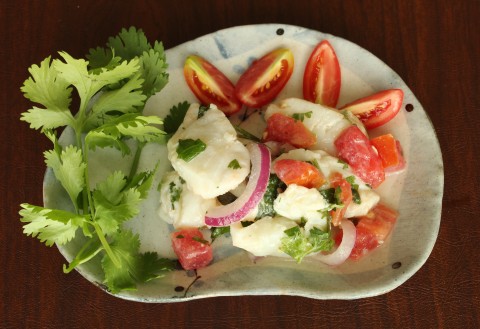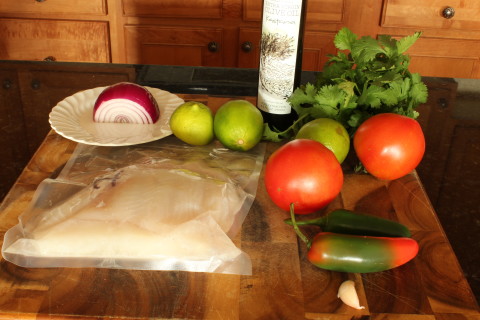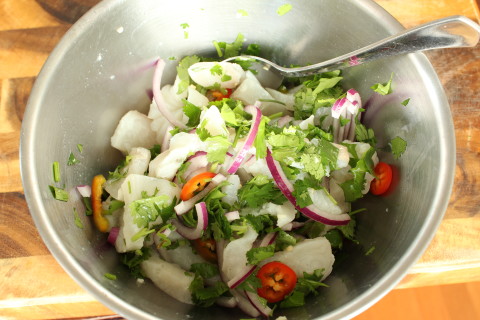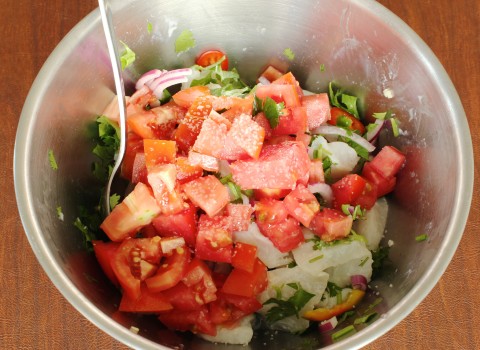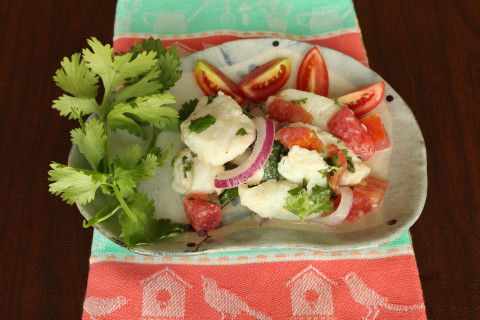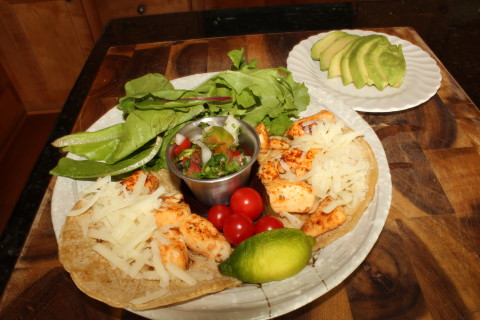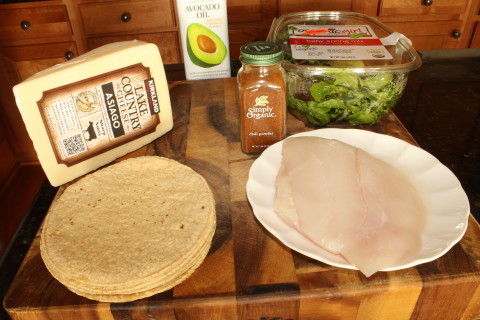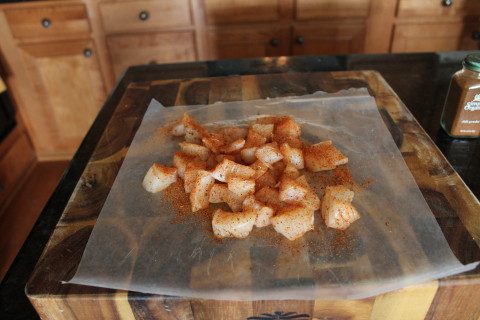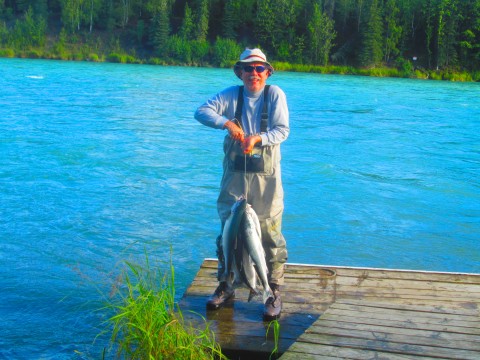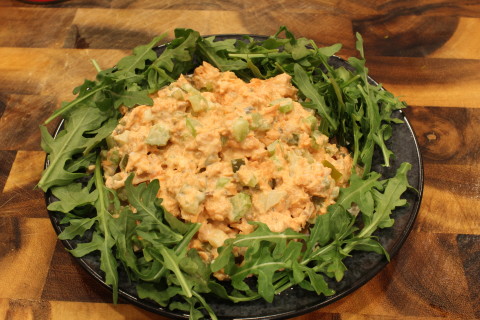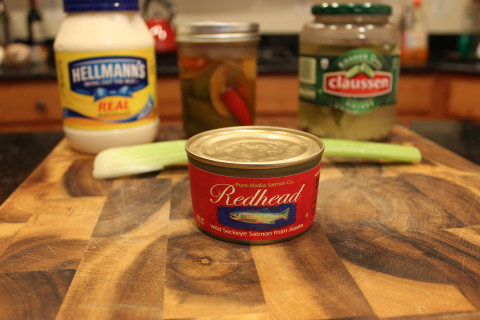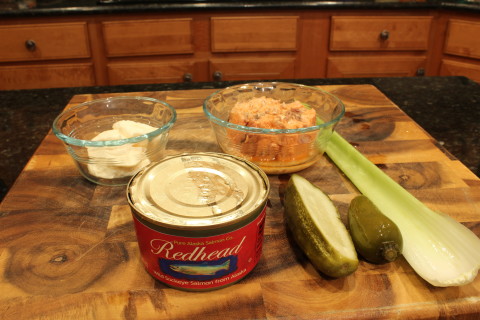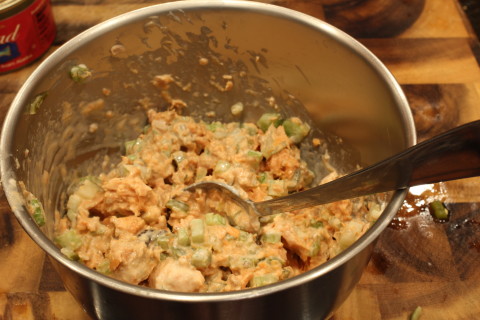Halibut Ceviche
Halibut Ceviche
1 pound halibut filet
1/2 cup lime juice
1/2 cup chopped or sliced red onion
1-2 fresh jalapeños sliced thin
1 small clove of garlic minced
1 1/2 tablespoons extra virgin olive oil
1 cup chopped cilantro
1 1/2 cup diced tomatoes
1 -1 1/2 teaspoons kosher salt
Cut halibut in pieces 1 1/2 inch long by 3/8 inch thick and however high that particular filet is.
Put lime juice, jalapeños, olive oil and garlic in a medium sized mixing bowl and mix briefly.
Add halibut, onion and cilantro and mix.
Add tomatoes and salt mixing gently to not break up the tomatoes.
Store in fridge covered for 24-36 hours mixing three times about every 8-12 hours.
Serve with tortilla chips and sliced avocado garnished with fresh cilantro.
Serves 6-8
Halibut Tacos
Halibut Tacos
1 pound halibut, cut into bite size pieces
1 tablespoon oil, avocado or regular olive oil
1 tablespoon blackening spice or chili powder*
4 ounces shredded asiago cheese
4 ounces of salad greens, or arugula
8 taco shells, hard or soft
Spread halibut out on a large plate or sheet pan and dust with blackening spice.*
In a 10-12 inch saute pan heat oil on med-high heat just until it starts to smoke.
Add halibut and cook for 1-2 minutes before turning or stirring halibut. You want to get it cooked on all sides but don’t overcook it. After turning the halibut it only takes 2 minutes for it to be cooked.
Add cooked halibut to taco shells and then add cheese. Cook under a broiler for 1 minute if you want the cheese melted. I just let the heat of the halibut warm the cheese.
Add greens and serve with a side of salsa, or pico de gallo.
Serves four.
If you are using frozen halibut it is usually quite wet and needs to be dried on paper towels before dusting with blackening spice.
You can use just about any commercially available blackening spice blend sold in grocery stores. If not available here is a simple recipe to make your own:
1 T salt
1 T chili powder
1 t dried oregano
1 T paprika
1-2 t cayenne pepper
1 T granulated garlic
1 t onion powder
1 t dried thyme
2 t ground black pepper
Mix all ingredients together and you have your very own blackening spice.
Alaska Salmon Recipe
Alaska has been a big part of my life ever since 1974 when I first set foot on Kodiak Island. I wasn’t sold at the beginning but that first step planted the seed. What really did it was moving to the Kenai Peninsula in 1984, and learning how to catch salmon.
Back then the Kenai Peninsula was a wonderland of all things wild. There were moose in our yard all year long nibbling on just about anything green. Wolves followed their ancient ways in the nearby mountains and hills. Salmon crowded the Kenai River in numbers that blew my mind, and the Cook Inlet waters yielded monster sized halibut and tasty cod for my freezer. I no longer call the Great Land my home but I manage to get back at every opportunity. Since 1995, when I moved to Colorado, I have hardly missed a fishing trip to that magical place.
If I had $5,000 – $10,000 to spare, I’d just go to one of the fishing lodges where they do everything for you except hook and reel in the fish, but the lottery did not smile on me this year so that trip will have to wait. For six days this summer my family and I will head up to Alaska for a week at a DIY fishing camp. We will pursue the mighty King Salmon, halibut, rockfish, and lingcod to bring back for a year’s worth of the best seafood you can imagine.
I am so lucky to be able to afford and tolerate the rigors of a fishing vacation in Alaska year after year. It’s a lot of physical work to captain an 18 foot skiff in the open ocean or rivers in Alaska, and I’m not quite as strong as I used to be. Strength is important when fighting a 50 pound salmon or a halibut weighing over 200 pounds!
I hope we are spared the six foot seas on this trip, tough. If you have never been in an 18 foot skiff in rough Alaskan seas, you are missing some serious adrenaline! My brother and I barely made it around Danger Point near Angoon, Alaska on our last self-guided fishing adventure back in 2002.
This year, I expect to shoot hundreds of pictures and have my brother video parts of the trip. Watch for postings about this wilderness paradise of the Inside Passage, either on this blog or in travel media.
While I wait for the first fresh Alaskan Salmon to hit the local stores, canned salmon is a good thing to have in the pantry. Pure Alaska Salmon Company is as good as anything I have tried and it’s ultra-convenient to pop open a can for salmon cakes of salmon salad sandwiches. Pure Alaska’s salmon is processed just hours after being caught, and provides a lot of flavor and nutrition. It tastes as good as the last of my catch from last year, now frozen for ten months. athttp://www.purealaskasalmon.com/our-story-pure-alaska-salmon-company.
If you try their salmon, please let me know if you agree this is the best canned salmon out there, and please share this salmon salad recipe with friends and family. If you have not left a comment to enter last week’s post on Aztec Turkey you can still get in as the drawing is tonight for the box of hot pepper goodies from Melissa’s Produce!
Canned Salmon Salad
1 7.5 oz. can of red salmon, or 8 oz. fresh cooked salmon
1/4 cup chopped celery
2-3 tablespoon diced dill pickles
2 tablespoons of mayonnaise
1/4 teaspoon Spike seasoning salt
1 minced jalapeño, optional
In a 2 quart mixing bowl break up salmon into flakes, and remove bones if desired -I leave them in when using canned salmon.
In a small bowl mix mayonnaise, Spike, and jalapeño.
Pour over salmon.
Add celery and dill pickles.
Mix well and chill for an hour if you have the time to do so.
Serve over salad greens, on bread with some lettuce, or wrapped in a tortilla with salad greens.
Serves two but is easily doubled.
Even though Pure Alaska Salmon Company gifted me some of their canned salmon my opinions are my own.




